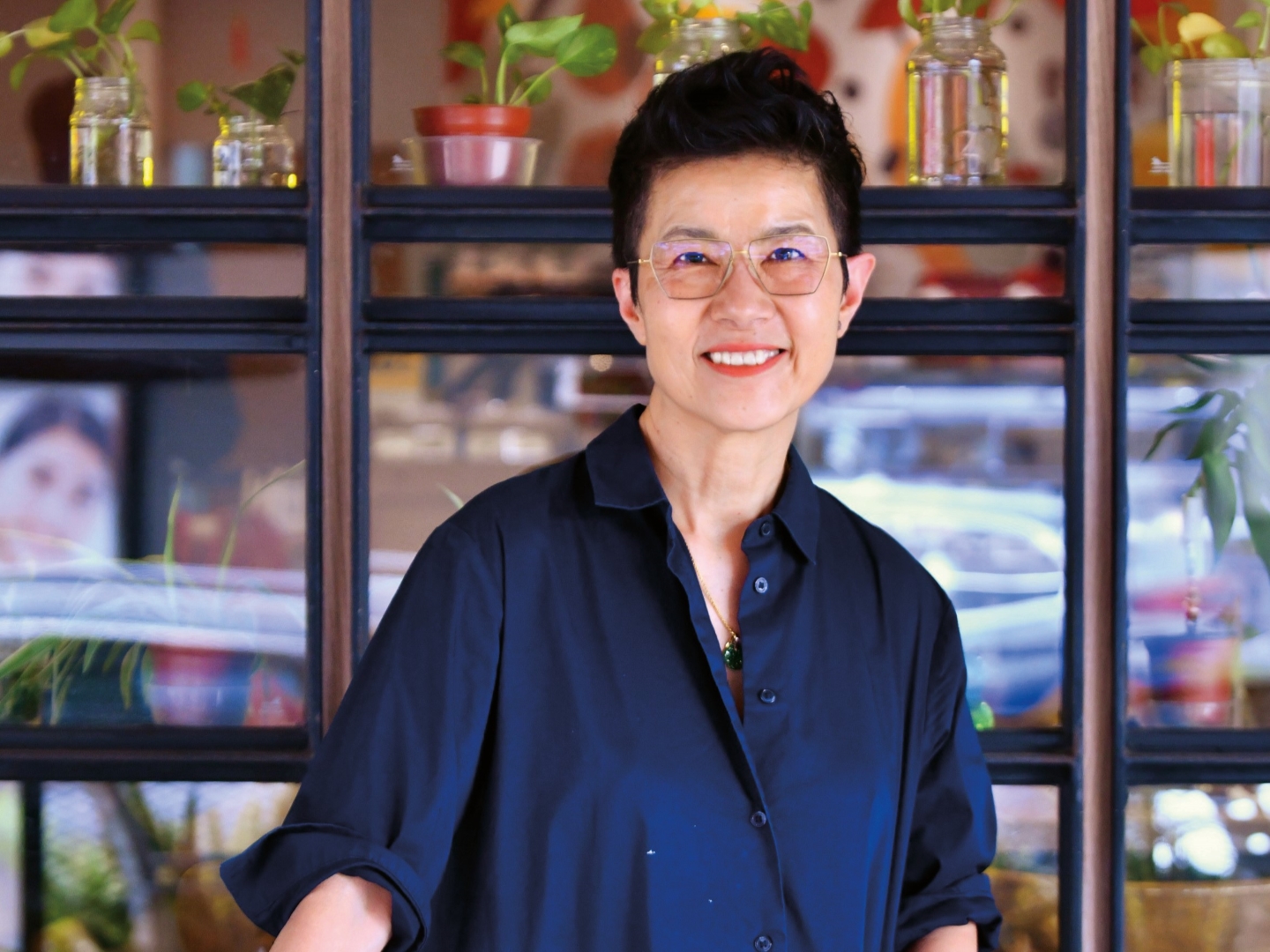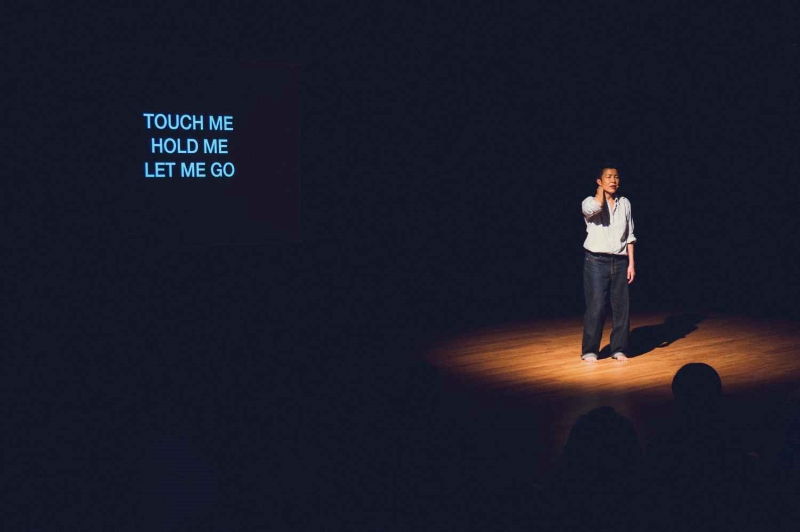
Touch Me Hold Me Let Me Go is a lecture, poem, workshop, recital, sing-along and dance-party, Lee says (Photo: Sam Fong/ The Edge)
Lee Su-Feh wants to create spaces where audiences have permission to feel the range of their bodies and are not defined by narrow codes. It does not mean they have to get up and do something.
“They can start to engage with the experience using the whole body rather than only their eyes or brain. I want to remind people there is a larger sensing intelligence in my body that’s not just ideas or in my head,” she says.
A performance maker, educator and writer who has been “exploring the human body as a site of intersecting habits and histories” for the last four decades, Lee understands spectators’ expectations: What am I going to get? What will I see or hear?
“For me as an artiste, it’s always, yes, I am going to give you something. I’m going to be dancing for you, singing for you. I’m going to tell you stories about the body, how it is connected to the natural world and how we are connected to one another.
“The idea is to give people an immersive experience of something that will lead them to decide how much they want to interact. I hope to bring them into feeling their bodies and be watching from a place where they are more relaxed.”
Touch Me Hold Me Let Me Go, a multimedia lecture performance slated for three shows starting March 5 in Kuala Lumpur, is about Lee trying to understand her body and looking at it through the lens of power.
Born and raised in Malaysia and based in Vancouver, Canada, for the last 30 years, she is acutely aware of relationships with power. “I grew up thinking to be a better person, you had to be white. Or play white. And I feel like I’m in a constant effort of undoing that idea in myself.”
Artistes need to pay attention to how the systems they grew up in have formed them, so as not to perpetuate harmful practices, consciously or otherwise, she thinks.
lee_su-feh_in_touch_me_hold_me_let_me_go_4_photo_by_yvonne_chew.jpg

“Our ideas of those with disabilities, queer people, transgender folks, how we are radicalised … We need to examine how we are complicit in the systems that rob us of our full humanity. We have a responsibility to look at ourselves and [the way] we internalise harmful ideas.”
Lee’s early associations with Five Arts Centre and teachers who “strove to find a contemporary Asian expression out of the remnants of colonialism and dislocated traditions” — among them Janet Pillai, under whom she did children’s theatre, and dancers Marion D’Cruz and the late Lari Leong — left indelible impressions on her, as did conversations with the late theatre director and critic Krishen Jit.
Touch Me Hold Me Let Me Go is a choreographic score, or what she calls “an algorithm” for dancing with the self, others and the planet, expressed through songs, music, poetry and movement. Along the way, those watching are invited, but not coerced, into an immersive ritual of breathing, listening, moving and singing together.
The show will introduce the audience to Fitzmaurice Voicework, which explores the dynamics between body, breath, voice, the imagination, language and presence. Lee, a practitioner and trainer of this approach for about 15 years, finds it spiritual and enriching.
“When I teach it, I’m also trying to model work that makes me a better human being. It helps me listen more intently to other people and myself so that I can hear my own convictions. In many ways in what I do, I’m trying to create conditions where the audience starts to feel into the body and find there’s a wisdom we can listen to and trust.”
She is quick to brush off the notion that people here are not ready for her work. “That’s an old story. I don’t think we live in that kind of world anymore, because knowledge gets everywhere. Certainly, the West can learn from the kind of diversity Malaysians live in.
“Here, your body is very used to hearing [diverse] languages and moving in different spaces where the rules differ. I think people have a way of code-switching and understanding them even if they’re not conscious of it. Whereas if you live in, say, Canada or the US, where there’s some sort of standard or a dominant way of doing things, which some people may find easier, things get lost.”
lee_su-feh_in_touch_me_hold_me_let_me_go_performance_shot.jpg

On why she creates, Lee says: “I don’t discount the need for [shows] to be amusing or entertaining, but I’m trying to make work that engages people and invites them into an experience that is interesting for them. There’s a difference between being curious about something and being entertained.”
Not allowing narrow codes to define her started early for Lee, who decided she wanted to continue with martial arts after starting dance because it has a function related to physics, structure and focus. Also, it is more than just about looking pretty. “Why arrange the body into those beautiful standards that can really be harmful?”
Lee did ballet — “I’m not very good at it” — and lots of contemporary dance. Martial arts kept her grounded because “when we start to worry about whether you are thin enough, it messes with your head”. What she finds most appealing about the training is that it also involves contact improvisation; the forms are less about aesthetics than the physics of the body and creating a relationship with another.
Pre-pandemic, she would return to Malaysia every two or three years for a couple of weeks each trip, as that was all the time she could afford.
In 2023, on her first international trip in five years, she stayed two months and “got the feeling I really want to come back regularly, deepen my relationships with people here and try to connect more with the homeland”.
Covid-19 made her realise a lot of her work could be done online. Also, with her only child graduating next month, she wants to engage creatively with local and Southeast Asian artistes.
“That has become more fulfilling as the work gets me in artistic dialogue with people in relationships that are not just superficial.”
Lee did the first draft of Touch Me Hold Me Let Me Go in the country. From her experience of teaching and performing here the last three years, she finds Malaysians “very adventurous. They are ready to show up, move and use their bodies”.
23-tmhmlmg-3.jpg

Will there come a time when the dancer’s body cannot perform the way she wants it to?
“I learnt martial arts from old men. One was 75 when I started and he was my teacher for 10 years. The other was in his 70s and died in his 80s.
“I don’t think your dancing will change [with age]. But why try to dance the way you did when you were 20 or 25? Or have those longings that make you go, ‘Oh, I can’t do that anymore’?
“You can do other things, and much better than the 25-year-old. Besides dancing, there is always teaching, right? But I intend to dance till the day I die.”
When Lee returns to Vancouver at the end of March, it will be back to research for a master’s in performing arts. Her focus is the role of dance, music and singing in performance, and how they affect the nervous system, as well as using sound and movement principles to create shows where people can experience their bodies more fully and come to a healthier physical self.
“Dancing teaches us so much about how to be with ourselves and one another. Neuroscience backs that,” she adds. It has been found to improve cognitive-motor function and worldwide, Parkinson’s patients do dance regularly as it helps slow down the loss of motor skills.
Singing has beneficial effects for mind and body too. It slows the breath down and calms the nervous system.
“It takes you out of anxiety. When you sing with others, you listen to human voice; you’re listening to when you can join with that other human body.
“All that is good for us. They give us signals that we are safe. When the body feels safe, our nervous system can recalibrate and heal. Our cells heal from stress and we get energy back again.
“To me, dancing and singing are also metaphors for communal care. I think we need more of that.”
'Touch Me Hold Me Let Me Go' will be staged by Five Arts Centre at GMBB, KL, on March 5 and 7 (8:30pm) and March 9 (3pm). Buy tickets (RM30/RM50) here.
This article first appeared on Mar 3, 2025 in The Edge Malaysia.


